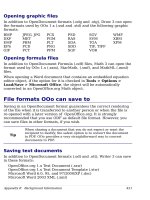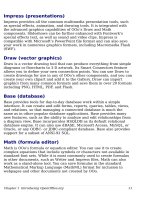Getting Started with Open Office .org 3 part 6 docx
Bạn đang xem bản rút gọn của tài liệu. Xem và tải ngay bản đầy đủ của tài liệu tại đây (4.77 MB, 10 trang )
Figure 31. Choosing HTML compatibility options
Import - Use 'English (USA)' locale for numbers
When importing numbers from an HTML page, the decimal and
thousands separator characters differ according to the locale of the
HTML page. The clipboard, however, contains no information about
the locale. If this option is not selected, numbers will be interpreted
according to the Language - Locale setting in Tools > Options >
Language Settings > Languages (see page 53). If this option is
selected, numbers will be interpreted as for the English (USA)
locale.
Import - Import unknown HTML tags as fields
Select this option if you want tags that are not recognized by OOo to
be imported as fields. For an opening tag, an HTML_ON field will be
created with the value of the tag name. For a closing tag, an
HTML_OFF will be created. These fields will be converted to tags in
the HTML export.
Import - Ignore font settings
Select this option to have OOo ignore all font settings when
importing. The fonts that were defined in the HTML Page Style will
be used.
Export
To optimize the HTML export, select a browser or HTML standard
from the Export box. If OpenOffice.org Writer is selected, specific
OpenOffice.org Writer instructions are exported.
Export - OpenOffice.org Basic
Select this option to include OOo Basic macros (scripts) when
exporting to HTML format. You must activate this option
before
you
Chapter 2 Setting up OpenOffice.org 51
create the OpenOffice.org Basic macro; otherwise the script will not
be inserted. OpenOffice.org Basic macros must be located in the
header of the HTML document. Once you have created the macro in
the OpenOffice.org Basic IDE, it appears in the source text of the
HTML document in the header.
If you want the macro to run automatically when the HTML
document is opened, choose Tools > Customize > Events. See
Chapter 13 (Getting Started with Macros) for more information.
Export - Display warning
When the OpenOffice.org Basic option (see above) is
not
selected,
the Display warning option becomes available. If the Display
warning option is selected, then when exporting to HTML a
warning is shown that OpenOffice.org Basic macros will be lost.
Export - Print layout
Select this option to export the print layout of the current document
as well. The HTML filter supports CSS2 (Cascading Style Sheets
Level 2) for printing documents. These capabilities are only effective
if print layout export is activated.
Export - Copy local graphics to Internet
Select this option to automatically upload the embedded pictures to
the Internet server when uploading using FTP.
Export - Character set
Select the appropriate character set for the export.
Choosing language settings
You may need to do several things to set the language settings to what
you want:
• Install the required dictionaries
• Change some locale and language settings
• Choose spelling options
Install the required dictionaries
OOo3 automatically installs several dictionaries with the program. To
add other dictionaries, use Tools > Language > More Dictionaries
Online. OOo will open your default web browser to a page containing
links to additional dictionaries that you can install. Follow the prompts
to install them.
52 Getting Started with OpenOffice.org 3
Change locale and language settings
You can change some details of the locale and language settings that
OOo uses for all documents, or for specific documents.
In the Options dialog, click Language Settings > Languages.
Figure 32: Language Setting Options
On the right-hand side of the
Language Settings – Languages
page
(Figure 33), change the
User interface, Locale setting
,
Default
currency
, and
Default languages for documents
as required. In the
example, English (UK) has been chosen for all the appropriate settings.
If you want the language (dictionary) setting to apply to the current
document only, instead of being the default for all new documents,
select the option labelled
For the current document only
.
Figure 33: Choosing language options
If necessary, select the options to enable support for Asian languages
(Chinese, Japanese, Korean) and support for CTL (complex text layout)
languages such as Hindi, Thai, Hebrew, and Arabic. If you choose
either of these options, the next time you open this dialog, you will see
some extra choices under Language Settings, as shown in Figure 34.
These choices (
Searching in Japanese
,
Asian Layout
, and
Complex Text
Layout
) are not discussed here.
Chapter 2 Setting up OpenOffice.org 53
Figure 34: Extra pages available when enhanced language
support options are selected
Choose spelling options
To choose the options for checking spelling, click Language Settings
> Writing Aids. In the
Options
section of the page (Figure 35), choose
the settings that are useful for you. Some considerations:
• If you do not want spelling checked while you type, deselect
Check spelling as you type and select Do not mark errors. (To
find the second item, scroll down in the Options list.)
• If you use a custom dictionary that includes words in all upper
case and words with numbers (for example, AS/400), select
Check uppercase words and Check words with numbers.
• Check special regions includes headers, footers, frames, and
tables when checking spelling.
Figure 35: Choosing languages, dictionaries, and options
for checking spelling
54 Getting Started with OpenOffice.org 3
Here you can also check which user-defined (custom) dictionaries are
active by default, and add or remove dictionaries, by clicking the New
or Delete buttons.
Choosing Internet options
Use the Internet Options pages to define search engines and save
proxy settings for use with OpenOffice.org.
If you are using a Netscape or Mozilla browser (such as Firefox), you
can enable the Mozilla Plug-in so you can open OOo files in your
browser, print them, save them, and work with them in other ways.
If you are using a Unix- or Linux-based operating system (including
Mac OS X), an additional page of E-mail options is available, where you
can specify the e-mail program to use when you send the current
document as e-mail (Figure 36). Under Windows the operating
system’s default e-mail program is always used.
Figure 36: Internet options, showing E-mail page available
to Linux users.
Controlling OOo’s AutoCorrect functions
Some people find some or all of the items in OOo’s AutoCorrect
function annoying because they change what you type when you do not
want it changed. Many people find some of the AutoCorrect functions
quite helpful; if you do, then select the relevant options. But if you find
unexplained changes appearing in your document, this is a good place
to look to find the cause.
To open the AutoCorrect dialog, click Tools > AutoCorrect. (You need
to have a document open for this menu item to appear.)
In Writer, this dialog has five tabs, as shown below. In other
components of OOo, the dialog has only four tabs.
Chapter 2 Setting up OpenOffice.org 55
Figure 37: The AutoCorrect dialog in Writer, showing the
five tabs and some of the choices
56 Getting Started with OpenOffice.org 3
Chapter 3
Using Styles and Templates
What is a template?
A
template
is a model that you use to create other documents. For
example, you can create a template for business reports that has your
company’s logo on the first page. New documents created from this
template will all have your company’s logo on the first page.
Templates can contain anything that regular documents can contain,
such as text, graphics, a set of styles, and user-specific setup
information such as measurement units, language, the default printer,
and toolbar and menu customization.
All documents in OpenOffice.org (OOo) are based on templates. You
can create a specific template for any document type (text,
spreadsheet, drawing, presentation). If you do not specify a template
when you start a new document, then the document is based on the
default template for that type of document. If you have not specified a
default template, OOo uses the blank template for that type of
document that is installed with OOo. See “Setting a default template”
on page 74 for more information.
What are styles?
A
style
is a set of formats that you can apply to selected pages, text,
frames, and other elements in your document to quickly change their
appearance. When you apply a style, you apply a whole group of
formats at the same time.
Many people manually format paragraphs, words, tables, page layouts,
and other parts of their documents without paying any attention to
styles. They are used to writing documents according to
physical
attributes. For example, you might specify the font family, font size,
and any formatting such as bold or italic.
Styles are
logical
attributes. Using styles means that you stop saying
“font size 14pt, Times New Roman, bold, centered”, and you start
saying “Title” because you have defined the “Title” style to have those
characteristics. In other words, styles means that you shift the
emphasis from what the text (or page, or other element) looks like, to
what the text
is
.
Styles help improve consistency in a document. They also make major
formatting changes easy. For example, you may decide to change the
indentation of all paragraphs, or change the font of all titles. For a long
document, this simple task can be prohibitive. Styles make the task
easy.
58 Getting Started with OpenOffice.org 3
In addition, styles are used by OpenOffice.org for many processes,
even if you are not aware of them. For example, Writer relies on
heading styles (or other styles you specify) when it compiles a table of
contents. Some common examples of style use are given in “Examples
of style use” on page 79.
OpenOffice.org supports the following types of styles:
•
Page styles
include margins, headers and footers, borders and
backgrounds. In Calc, page styles also include the sequence for
printing sheets.
•
Paragraph styles
control all aspects of a paragraph’s appearance,
such as text alignment, tab stops, line spacing, and borders, and
can include character formatting.
•
Character styles
affect selected text within a paragraph, such as
the font and size of text, or bold and italic formats.
•
Frame styles
are used to format graphic and text frames,
including wrapping type, borders, backgrounds, and columns.
•
Numbering styles
apply similar alignment, numbering or bullet
characters, and fonts to numbered or bulleted lists.
•
Cell styles
include fonts, alignment, borders, background, number
formats (for example, currency, date, number), and cell
protection.
•
Graphics styles
in drawings and presentations include line, area,
shadowing, transparency, font, connectors, dimensioning, and
other attributes.
•
Presentation styles
include attributes for font, indents, spacing,
alignment, and tabs.
Different styles are available in the various components of OOo, as
listed in Table 1.
OpenOffice.org comes with many predefined styles. You can use the
styles as provided, modify them, or create new styles, as described in
this chapter.
Chapter 3 Using Styles and Templates 59
Table 1. Styles available in OOo components
Style Type Writer Calc Draw Impress
Page X X
Paragraph X
Character X
Frame X
Numbering X
Cell X
Presentation X X
Graphics (included in
Frame styles)
X X
Applying styles
OpenOffice.org provides several ways for you to select styles to apply.
Using the Styles and Formatting window
1) Click the Styles and Formatting icon located at the left-hand
end of the object bar, or click Format > Styles and Formatting,
or press
F11
. The Styles and Formatting window shows the types
of styles available for the OOo component you are using. Figure
38 shows the window for Writer, with Page Styles visible.
You can move this window to a convenient position on the screen
or dock it to an edge (hold down the
Ctrl
key and drag it by the
title bar to where you want it docked).
2) Click on one of the icons at the top left of the Styles and
Formatting window to display a list of styles in a particular
category.
3) To apply an existing style (except for character styles), position
the insertion point in the paragraph, frame, or page, and then
double-click on the name of the style in one of these lists. To apply
a character style, select the characters first.
Tip
At the bottom of the Styles and Formatting window is a
dropdown list. In Figure 38 the window shows
Automatic
,
meaning the list includes only styles applied automatically by
OOo. You can choose to show all styles or other groups of
styles, for example only custom styles.
60 Getting Started with OpenOffice.org 3









